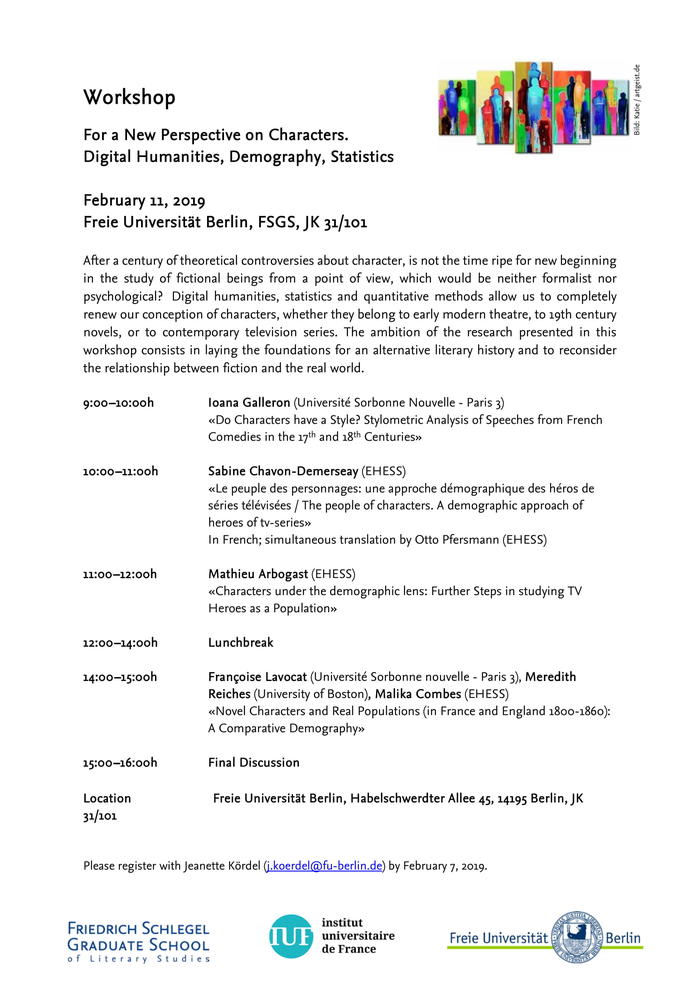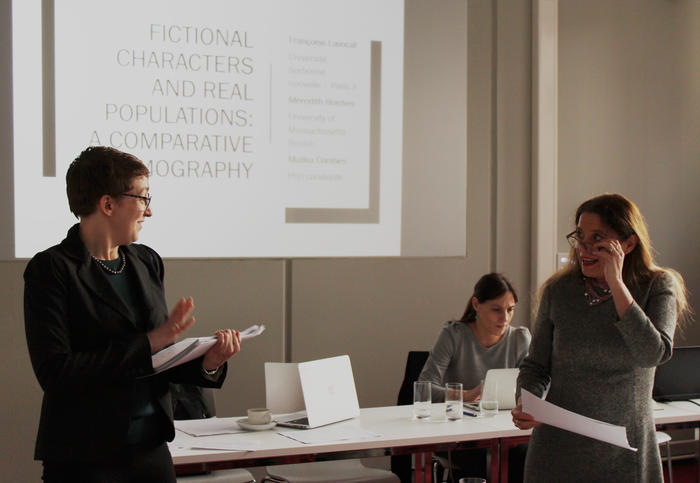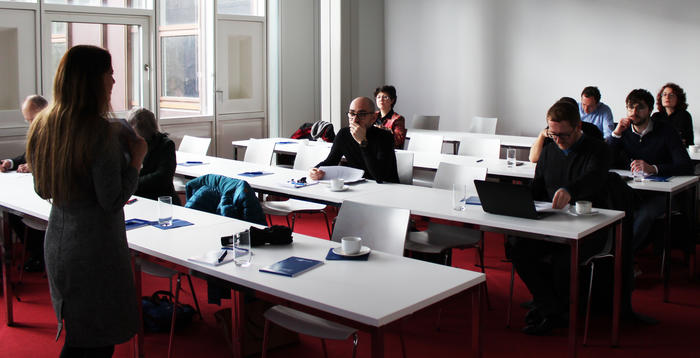For a New Perspective on Characters. Digital Humanities, Demography, Statistics
Program "For a New Perspective on Characters"
Bildquelle: FSGS
Bildquelle: FSGS
Bildquelle: FSGS
Bildquelle: FSGS
Ort: JK 31/101
Organisation: Françoise Lavocat und Meredith Reiches
Anmeldung: bis 07.02.2019 an Jeanette Kördel (j.koerdel@fu-berlin.de)
What can we learn about narrative production by considering characters as members of fictional populations whose lives and utterances can be analyzed with demographic and statistical methods? The workshop featured four presentations that spanned epochs and forms of media, including seventeenth- and eighteenth-century French theatre (Ioanna Calderon), nineteenth-century French and British novels (Françoise Lavocat, Meredith Reiches, Malika Combes), twentieth-century televised French series (Sabine Chavon-Demerseay), and twenty-first century televised police dramas (Mathieu Arbogast). Despite temporal and formal differences in the objects of study, researchers converged on shared methodological questions, discovered common patterns in their data, and formulated hypotheses to investigate the relationship between demographic patterns in narrative and the cultural and historical contexts in which the objects of study were produced.
Ioanna Galleron presented preliminary findings from digital humanities projects using natural language processing to identify named characters and engaging in stylometric analysis through principle components analysis. She identified 5167 characters in digitized databases of seventeenth- and eighteenth-century plays and mapped the distances between a subset of them based on each character’s most frequently used words.
Françoise Lavocat, Meredith Reiches and Malika Combes made the case for the concept of a demographic style—that is, a mode of representing populations characteristic of individual authors, the writers of a given sex or class, or the novelists of a nation. They presented a database of demographic information including 14,229 named characters from 246 nineteenth-century French and British novels. Data had been coded by individual readers and in some cases extracted from character indexes. Using nineteenth-century French and British censuses, the researchers compared demographic patterns in fictional and historical populations.
Sabine Chavon-Demerseay outlined a model for heroes of televised series, identifying the way in which viewers identify actors with their recurring roles, blurring lines between biographical fact and narrative fiction. Data sources included TV guides, websites that collect and publish information about actors, and official archives of French television. She applied both demographic and sociological methods to describe 51,774 characters from 440 series.
Mathieu Arbogast treated female protagonists of contemporary police dramas as a demographic intervention in a traditionally male role with the potential to change the population dynamics of the genre. Applying transdisciplinary methods including event-based sociology and cohort building, he characterized the gender, age, and racial/ethnic composition of 36 prime time series.
One striking commonality to emerge out of the four research programs was the persistent underrepresentation of women in fictional universes. Women seldom comprised more than 30% of characters, whether in plays, novels, or televised series, though each narrative form operated under different production constraints. Lavocat and colleagues noted that novels written by women were frequent exceptions: in each of Jane Austen’s works, for example, circa 50% of characters were female. Galleron found that not only did female characters speak fewer words in the plays she analyzed, but their styles of speech differed in consistent ways from men’s; for instance, female characters used fewer adjectives. Chavon-Demerseay’s data showed that women were highly represented only among young characters years, and Arbogast demonstrated that, in police drama, the younger average age of female characters was due in part to actresses having shorter tenures on the series. In addition, they noted that fictional characters tended to enjoy higher social and professional status and standards of living than their average historical counterparts.
Methodologically, researchers grappled with how best to count unnamed characters, groups, and crowds as part of fictional universes. They noted the difficulties inherent in extracting trustworthy and consistent data from heterogeneous sources, many of which were compiled by volunteers and required vetting. They also debated to what extent the concept of genre was useful for categorizing forms of narrative production, particularly in an age when boundaries between narrative forms and modes of access were becoming increasingly fluid.
The tensions among quantitative analyses of fictional demography and speech, close reading of written or televised narratives, and historical contextualization were also discussed. Readers, viewers, and the markets they create emerged as forces likely to shape the populations of fictional universes. Efforts to compare fictional to historical and contemporary populations, it was proposed, benefit from an investigation of how people perceived and perceive the populations they inhabit.
Participants reflected on the relationship of their methods to traditional theories and strategies of literary criticism and to adjacent and distant disciplines. Demography, sociology, anthropology, and history all furnished perspectives and techniques that researchers used to approach vast numbers of literary works and characters with novel questions. Narratological, ontological and actantial approaches informed researchers’ modes of inquiry but were, of themselves, an incomplete description of their techniques or findings. It was agreed that literary studies would benefit from a demographic turn as a way to expand the scope of claims that could be made about a given corpus.
Program
09:00 Uhr Ioana Galleron (Université Sorbonne Nouvelle - Paris 3)
«Do Characters have a Style? Stylometric Analysis of Speeches from French Comedies in the 17th and 18th Centuries»
10:00 Uhr Sabine Chavon-Demerseay (EHESS)
«Le peuple des personnages: une approche démographique des héros de séries télévisées / The people of characters. A demographic approach of heroes of tv-series»
11:00 Uhr Mathieu Arbogast (EHESS)
«Characters under the demographic lens: Further Steps in studying TV Heroes as a Population»
12:00 Uhr Lunch
14:00 Uhr Françoise Lavocat (Université Sorbonne nouvelle - Paris 3), Meredith Reiches (University of Boston), Malika Combes (EHESS)
«Novel Characters and Real Populations (in France and England 1800-1860): A Comparative Demography»
15:00 Uhr Final Discussion









